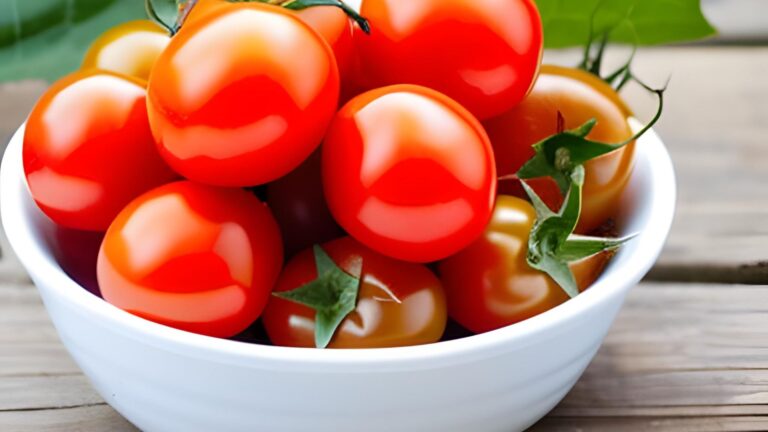In This Article
When To Plant Tomatoes In Ohio? (Best Time and Expert Tips)
Growing tomatoes is a favorite summer activity for many gardeners in Ohio. The taste of a fresh, homegrown tomato is hard to beat! However, in order to get a bountiful tomato harvest, it’s important to know the optimal time to plant tomatoes in Ohio’s climate.
Why Timing Matters For Planting Tomatoes In Ohio
- Tomatoes are warm-weather crops that thrive in temperatures between 70-85°F. Planting too early or late can affect growth and yield.
- Ohio’s last frost date varies across the state, ranging from mid-April along the Ohio River to early June in the snowbelt regions of northeast Ohio. Planting before the last frost can damage plants.
- Soil temperature is just as crucial as air temperature. Tomatoes won’t grow well until the soil has warmed to at least 60°F.
- Getting tomatoes in the ground at the right time allows them to mature and produce fruit during the warmest parts of summer.
When To Plant Tomatoes In Different Regions of Ohio
Ohio has several distinct climate regions that require different tomato planting dates. Use this guide based on your location:
Southwest Ohio
This region enjoys the longest growing season in Ohio, with a last spring frost date around April 15-20.
- Start seeds indoors: 6-8 weeks before the last frost, around early March.
- Transplant seedlings outdoors: 2 weeks after the last frost, early to mid-May.
- Plant purchased plants: Mid to late May.
Central Ohio
Central Ohio falls in the middle, with a last frost around April 25-May 15.
- Start seeds indoors: 6-8 weeks before the last frost, mid-March to early April.
- Transplant outdoors: 2 weeks after last frost, mid to late May.
- Plant purchased plants: Late May.
Northeast Ohio
The snowbelt region along the lakes has the shortest growing season, with a last frost as late as May 25-June 15.
- Start seeds indoors: 6-8 weeks before the last frost, early to mid-April.
- Transplant outdoors: 2 weeks after the last frost, early to mid-June.
- Plant purchased plants: Mid-June.
Key Dates By Ohio Region
| Region | Last Frost Date | Start Seeds Indoors | Transplant Outdoors | Plant Store Bought |
|---|---|---|---|---|
| Southwest Ohio | April 15-20 | Early March | Early to mid-May | Mid to Late May |
| Central Ohio | April 25-May 15 | Mid-March to Early April | Mid to Late May | Late May |
| Northeast Ohio | May 25-June 15 | Early to Mid-April | Early to Mid-June | Mid-June |
How To Determine Your Local Last Frost Date
Want to pin down your specific area’s last spring frost date so you know precisely when to plant? Here are a few ways to find out:
- Check with your local county extension office – they often provide planting calendars tailored to your county.
- Look at the NOAA Spring Frost Probabilities map for Ohio – it shows freeze risk by geographic area.
- Observe nature in your neighbourhood for clues spring has sprung, like blooming crocuses and daffodils. Hold off planting tomatoes until about 2 weeks after these early bulbs bloom.
- Track soil temperature at your location, waiting until it’s consistently 60°F or above at 4 inches deep before transplanting.
- Keep records from previous seasons – when did you safely transplant tomatoes in prior years without cold damage?
How To Time Tomato Planting For Best Success
Follow these tips to get your tomatoes off to the right start:
Start seeds indoors
Getting a head start on tomato seedlings indoors allows the plants to grow larger and heartier before their permanent home outdoors. Wait until your region’s recommended time frame (see dates above), sowing seeds 6-8 weeks before your anticipated transplant date.
Use heating mats
Warm the soil to at least 70°F for best germination. Heating mats and grow lights are useful for maintaining proper temperatures.
Harden off seedlings
Gradually expose indoor seedlings to outdoor conditions over 7-10 days. Set them outside in partial shade for a few hours each day, bringing in at night, increasing time outdoors. This toughens them up before transplant.
Transplant on a calm, cloudy day
Choose an overcast, wind-free day to transplant for less stress on seedlings. Water soil well the day before. Gently remove seedlings, keeping roots intact, and plant at the same depth as the pot. Water well immediately after transplanting.
Use season-extending devices.
Floating row covers, cold frames, and cloches can protect from frost. Don’t use plastic – it overheats plants. Ventilate on sunny days. Remove covers when night temps stay above 55°F.
Wait for soil warmth.
Even if air temps seem warm enough, ensure the soil is at least 60°F before transplanting. Use a soil thermometer to check.
Allow proper spacing
Give tomato plants enough room to grow. Plant indeterminate varieties 2-3 feet apart, determinate types 1-2 feet apart. Cage or stake tomatoes to keep fruits off the ground.
What If It’s Too Late To Plant?
Did you miss the ideal window for planting tomatoes in your region? Not to worry, you can still get a tomato crop using these strategies:
- Switch to early variety tomatoes, which take 55-70 days to harvest. Great Lakes, Siberian, Wisconsin 55, and Early Girl are good choices.
- Buy the largest tomato transplants you can find, which will give fruits soonest. Choose stocky plants vs. leggy ones.
- Prune lower leaves and branches of transplants so the plants can focus energy on ripening first fruits.
- Protect transplants with cloches, fabric covers, or hot caps to keep warm, especially at night.
- Pinch off any flowers or fruits that form in the first 2-3 weeks after planting to allow establishment.
- Use black or red plastic mulch to heat soil (transforms light into thermal energy).
- Fertilize regularly with a balanced vegetable food to fuel growth and fruiting. Fish emulsion is a good organic choice.
Common Tomato Planting Mistakes To Avoid
Learning from mistakes is part of the gardening journey. Steer clear of these common tomato pitfalls:
- Planting too early – hard frosts can kill seedlings. Wait until soil and air temps are reliably warm.
- Setting out leggy seedlings – stocky, compact plants with short internodes transplant best.
- Planting too deep – set seedlings at the same soil depth as in pots to avoid stem rot.
- Skipping hardening off – gradually introduced to outdoor conditions over 7-10 days before transplanting.
- Crowding plants – tomatoes need adequate airflow and light penetration. Follow spacing guidelines.
- Forgetting to stake/cage – support plants to prevent fruit from contacting soil and rotting.
- Overwatering – tomatoes don’t like wet feet. Allow soil to partially dry between waterings.
- Applying too much nitrogen fertilizer – emphasizes leafy growth over fruit production. Use a balanced fertilizer instead.
Tomato Gardening Tips For Ohio’s Climate
Optimizing care once your tomatoes are planted can help overcome challenges from Ohio’s climate:
- Mulch around plants to conserve soil moisture and reduce weeds. Shredded leaves or straws work well.
- Water deeply and infrequently, 1-2″ per week. Avoid frequent light watering.
- Use drip irrigation or soaker hoses to target roots. Avoid wetting foliage, which can encourage disease.
- Stake, trellis or cage plants to improve air circulation and prevent disease.
- Prune suckers (shoots between main stems and leaves) to focus energy.
- Monitor for pests like hornworms and control as needed. Hand pick or use Bacillus thuringiensis.
- Pick fruits at peak ripeness to encourage more production. Don’t leave overripe tomatoes on vines.
- Harvest promptly before slugs, birds, and squirrels beat you to them!
Enjoy Tomato Bounty With These Classic Ohio Dishes
Put those vine-fresh tomatoes to good use by whipping up some classic Ohio recipes:
- Tomato sandwiches – layer thick slices between white bread with mayo. Add bacon for a BLT.
- Farmers market pasta – toss chopped tomatoes with garlic, basil, olive oil and cooked pasta. Top with parmesan.
- Tomato pie – bake halved tomatoes seasoned with oregano and parmesan in a pie crust.
- Tomato juice – process tomatoes and strain out seeds/skins. Chill and serve over ice.
- Gazpacho – blend chopped tomatoes, cucumber, onion, and bell pepper into chilled soup.
- Tomato gravy – simmer tomatoes into a savoury sauce for biscuits, chicken, meatloaf or fish.
- Corn and tomato salad – mix grilled corn kernels, diced tomatoes, onion and balsamic vinaigrette.
- Tomato jam – cook down tomatoes into a sweet/tart spread for sandwiches, cheese plates, and crackers.
- Fried green tomatoes – dredge unripe tomatoes in cornmeal and pan fry for a Southern favourite.
Conclusion
Timed properly for Ohio’s regional climates, garden-fresh tomatoes will reward you all summer long. Pay close attention to last frost dates, track soil temperature, harden off seedlings properly, and employ season-extending techniques if planting late. Avoid common mistakes like overwatering, and care for your tomatoes according to Ohio’s conditions. Before you know it, you’ll enjoy tomato bounty in classic Ohio dishes!

